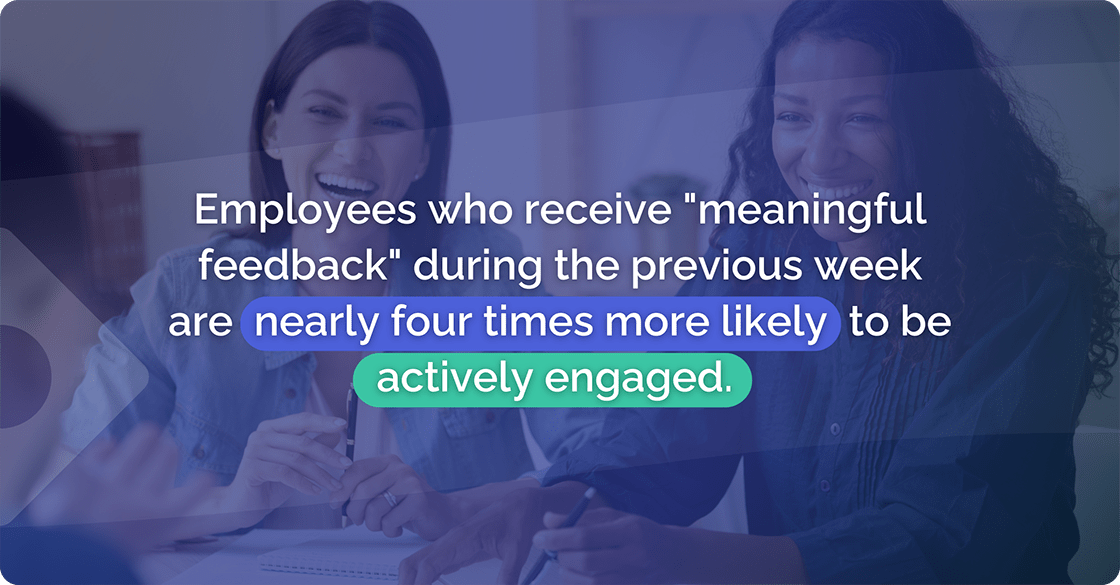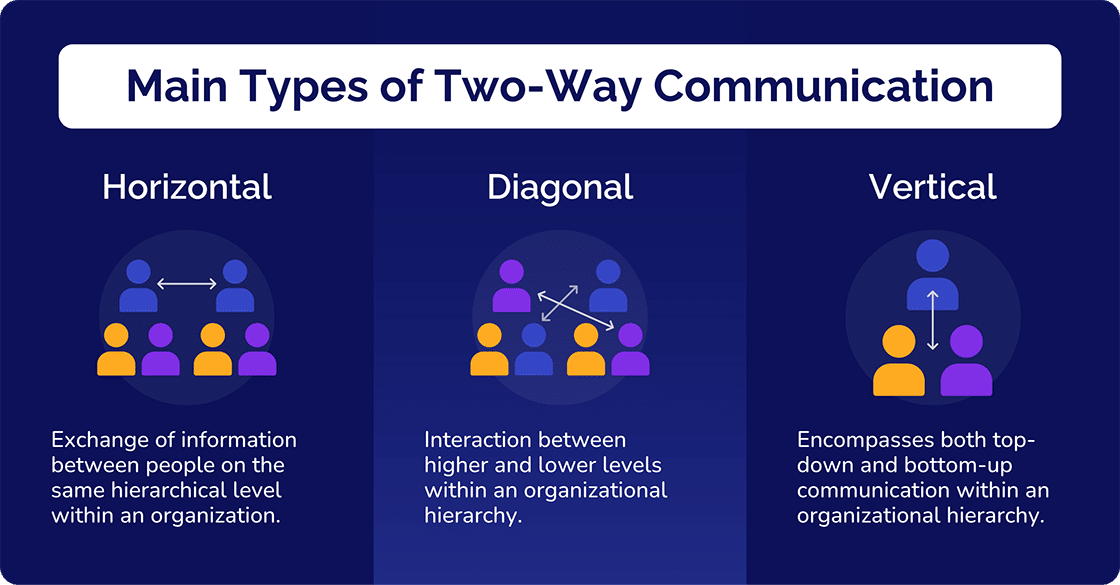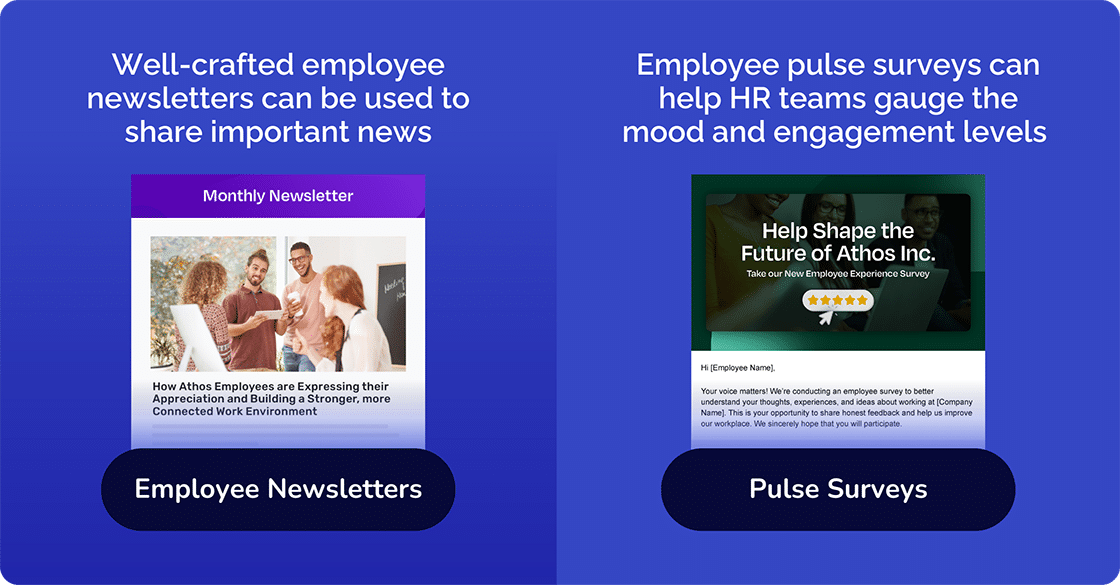 Employee Communication Best Practices
Employee Communication Best Practices
Two-way communication is a vital element that increases employee productivity. Want to increase your bottom line? Learn how — FREE.

.webp)
Effective internal communication is the backbone of every successful organization. Learn the ins and outs of internal communications with our research-backed white paper.
Access Now
Effective communication is the lifeblood of any successful business. Without clear and open channels that allow information to flow both ways, companies may falter and fail. That’s why two-way communication between management and employees is so vital.
As Gallagher states in Talent Benchmarks, the second in its 2025 Workforce Trends Report Series, “Engaged employees feel a stronger connection and commitment to the organization’s goals and values. Transparent communication about the organization, its mission, challenges, and successes helps build trust and confidence in leadership.” Yet their Benefits Strategy & Benchmarking Survey, in which 4,035 U.S. organizations participated, shows that nearly two out of three businesses experienced a turnover rate of 10% or more during 2024. Similarly, two in three leaders are concerned about the impact of stress and burnout on their organization.
“People are at the heart of everything you do, and aligning your people strategy with your overall business goals empowers them to maximize their capabilities and contributions.”
Gallagher
This is why employee engagement is so important when it comes to effective communication processes. However, employee engagement itself, along with recognition and the impact of stress, is a primary factor in meaningful communication. It’s not just about letting both parties have their say. That’s why we’ve decided to decode the benefits and best practices of two-way communication for you.
We’re going to look at what two-way communication is and how it differs from one-way communication. We’ll discuss why it is so critical in business, education, and everyday life, and outline what you have to do to implement a successful two-way communication system.
Turn your internal communications strategy around today

Two-way communication is a process that involves transmitting and receiving, speaking and listening, and accepting and responding to messages. Responses might be to what a team leader has said, what a colleague has said, or it may be a management response to employee feedback. This distinctive form of communication ensures there is an interactive and open exchange of information between two parties, in this context, between employers or business leaders and employees, or between employees or management.
Two-way communication ensures that both the sender and the person receiving the message engage in a collaborative conversation. It differs from the traditional top-down, hierarchical method of communication, where information typically flows from senior management to employees.
In our post on Top 20 Types of Internal Communication for Boosting Teamwork, we feature both top-down and two-way communication. When you study the 20 different types, you will see that while these have significant differences, all can be implemented in such a way that they offer a two-way communication strategy. For example, top-down communication, which flows from management down, as well as bottom-up, which flows from employees upward, can both become two-way communicators when they aim to attract feedback. Management can use top-down communication for surveys that ask for employee opinion, while bottom-up communication might seek feedback from team leaders on specific issues that concern them.
The essential element of two-way communication is simple. Whether it’s peer-to-peer communication where employees share ideas and opinions, or rewards and employee recognition communication from employers, as long as there is an opportunity for feedback and/or response, it becomes a two-way conversation. If response is not enabled, it is clearly one-way communication.
Two-way communication encourages employee engagement, enables employees to give valuable feedback to which they expect their employers to respond, provides critical insights, and creates a culture of community.

In the context of companies, two-way communication operates as an enabler for building trust with team members. When employees feel involved in the decision-making process, their commitment to the organization generally increases.
Further extending the process of two-way communication, human resources (HR) teams often make use of wellness checks for individual employees, list management techniques, and opt for annual employee surveys to gather critical feedback. Clear internal communication strengthens the organizational culture, in turn, leading to increased productivity.
You could liken the process of two-way communications to an air traffic control system. In a well-functioning two-way communication system in organizations, you will be able to identify regular updates, alerts, and feedback that maintain a smooth inflow and outflow of communication. So, just like in an air-traffic control station, ongoing information, feedback, and news keep everyone informed and moving in the same direction.
We decided to highlight a few research reports that prove just how important two-way communication is.
Cerkl is committed to elevating internal communications. So, it won’t surprise anyone that we keep abreast with research into the communications sector globally. We strongly believe that communication is king. But it has to be done the right way.
In a 2024 paper titled Two-way communication, retired Professor of Public Relations and Advertising, Michael L. Kent, discusses the value of two-way communication and its consequences. Typically, it is “interactive or conversational,” which distinguishes it from one-way communication. Furthermore, it is “characterized by genuine dialogue and engagement, rather than simply opportunities for interaction that are easily ignored.” Importantly, it starts when both people respect each other and use a method that allows for feedback. This feedback must be listened to and taken seriously. When this happens, it usually leads to more trust, better understanding, and a greater willingness to keep communicating.
“Two-way communication is inclusive, fundamental to interpersonal communication, and generally more rewarding than one-way communication.”
Michael L. Kent
The State of Organizations 2023 report by McKinsey & Company revealed that 43% of organizations struggle with a lack of purpose in communication, and 32% lack sufficient support for achieving individual purpose. Among its many findings, the report highlights that “purposeful communication is a skill and an art” and stresses the need for clear, consistent communication protocols.
In a more recent follow-up article, Five bold moves to quickly transform your organization’s culture, McKinsey highlights the role of two-way communication — particularly during culture transformation and change. Recognizing that employees often struggle to let go of entrenched behaviors, the authors advise that transformation leaders need to “ensure that they have two-way communications to track employee sentiment and shifts in behaviors and mindsets. Influencers will play a critical role in that plan.”
According to Gallup data, employees who receive frequent feedback from their managers are more likely to be engaged. However, they have found that only 27% of employees say they would like feedback at least weekly. This isn’t because they don’t want feedback, but rather that they generally find the feedback they get isn’t valuable.
Over time, Gallup has found that feedback needs to be “timely, authentic, and part of frequent check-ins” to be meaningful. Furthermore, the best feedback includes recognition and appreciation for who employees are and what they do. When feedback highlights employees’ strengths and what they do best, they receive it more positively and apply it more productively.
Ultimately, meaningful feedback is frequent, focused, and future-oriented, and it should be shared about once a week. Gallup research shows that it will then result in employees being nearly four times more likely to be actively engaged.

Generic forms of two-way communication are categorized by the way the information flows.

Of course, other types of communication may also be regarded as two-way communication systems. Peer-to-peer communication, where colleagues share ideas and feedback, is a typical two-way communication system. So too is operational communication, which encourages an exchange of ideas between employees across the board.
Two-way communication is the lifeblood of organizations. Companies argue that strong internal communications, underpinned by vibrant two-way interactions, are paramount for high employee engagement. This essentially refers to the capacity of team members to connect not just with their work, but also with their fellow colleagues and the overall organizational vision.
In terms of practical benefits, two-way communication allows companies to get direct feedback from their employees. This may be facilitated through various channels, including virtual town halls, employee pulse surveys, or even more informal chats around the proverbial virtual water cooler talk. The importance of feedback cannot be understated, as it enables organizations to identify areas that need improvement and act on them swiftly and decisively.
“When leaders throughout an organization take an active, genuine interest in the people they manage, when they invest real time to understand employees at a fundamental level, they create a climate for greater morale, loyalty, and, yes, growth.”
Patrick Lencioni, author of The Five Dysfunctions of a Team
Two-way communication also plays a huge role in fostering a positive organizational culture. A culture where all employees feel heard and valued breeds a sense of ownership and loyalty, which in turn leads to higher productivity and employee retention. Average companies communicate in one direction — from top to bottom. Great companies communicate in two directions — from top to bottom and from bottom to top.
But what happens when a team is dysfunctional? Let’s have a quick look at Patrick Lencioni’s dysfunctional team model.
Patrick Lecioni’s bestselling book, The Five Dysfunctions of a Team: A Leadership Fable, first published in 2002, highlights dysfunctions so that teams can overcome them. Many people recognize it as a foundational source of teamwork because they realize that all teams are potentially dysfunctional. So what are the five dysfunctions?
Turn your internal communications strategy around today

Integrating two-way communication effectively into your operations doesn’t need to be a difficult task. It simply requires strategic planning and commitment. Here are a few proven practices that can help spur effective two-way communication in your organization.
Adopt various communication platforms to reach more employees. Traditional means incorporating features like town hall meetings, employee surveys, and emails that can be used in tandem with more modern channels like communication chat apps and internal social media. For instance, weekly team meetings can be supplemented with continuous virtual chat dialogs on platforms like Facebook Messenger or WorkChat.
In today’s age of conversational commerce and pervasive connectivity, more informal platforms, including chat apps, have emerged as powerful communication tools that we can use to promote employee engagement. Regular virtual town halls, wellness checks, and pulse surveys can maintain the momentum of communication and ensure that all voices are heard. Businesses also generate survey links and QR codes using the best QR code generator and allow employees to provide anonymous input seamlessly by scanning through their smartphone or using the online QR Code Scanner.
In the same vein, well-crafted employee newsletters can be used to share important news. At the same time, they can offer an avenue for employees to share their personal opinions, successes, and ideas. Additionally, employee engagement surveys can help HR teams gauge the mood and engagement levels within the team, promoting an ongoing dialogue between management and staff.

Conducting regular virtual town halls and employee pulse surveys is a great way to ensure a smooth, continuous two-way communication process. Employee engagement and employee feedback are the core aims of these town halls and surveys.
Examples of effective two-way communication abound in the corporate world. Take the example of an organization that conducts town halls every quarter. Management explains their strategic decisions and future plans, then opens the floor for employees to ask questions and share their thoughts on the agenda. This way, the organization gets valuable feedback while the employees feel included in the decision-making process.
An illustration closer to the ground might be a manager who doesn’t just send out directives through emails, but also encourages responses. By asking for feedback and suggestions, this manager fosters an environment where relationships are facilitated and individual contributions are recognized.
Some other examples are:
Two-way communication is at the heart of effective employee engagement and a robust organizational culture. Little wonder, organizations harnessing this key to unlock the full potential of their workforce are far ahead of those that do not. It leads to an environment of trust, promotes positivity, and improves decision-making. In a study guide on organizational behavior, two-way communication was mentioned as a crucial determinant of individual behavior in workplaces.
Internal communication has evolved with the advent of digital technology. Businesses are increasingly adopting various tools like virtual town halls, employee pulse surveys, employee emails, employee newsletters, chat apps, and other kinds of employee feedback mechanisms to make their employees feel heard.
HR teams play a pivotal role in implementing two-way communication systems. They are akin to the air traffic control of organizational communication, ensuring messages and feedback circulate efficiently. Studies have shown a direct correlation between effective communication and the level of trust within an organization. By opening up channels for employees to voice their opinions, ideas, and concerns, businesses build a leveled field that fosters transparency and trust.
Cerkl Broadcast’s internal communication software is designed for two-way communication. It serves as a centralized hub for all communication assets, ensuring that internal communicators can easily access and manage information, making long-term planning much more effective.
Broadcast’s omnichannel capability is particularly effective for two-way communication. It removes the need for those in charge to select channels for most internal comms. Instead, Broadcast delivers across the channels employees already use, and communicators can target by audience and channel. This means all employees can access comms wherever they are, on-site, in a remote location, or even in another country.
The Broadcast platform also offers great content scheduling features. For example, communicators can strategically plan the timing and frequency of messages to reach employees at the best possible time.
Another advantage of Cerkl Broadcast’s versatile platform is that it enables communicators to segment their audience based on criteria like department, role, or location. This facilitates precise and hugely beneficial targeting when it comes to communication planning.
We’ve talked about the importance of feedback from employees and how surveys are a vital tool. Pulse surveys are a particularly effective tool when it comes to feedback. With Broadcast, you can include a pulse survey element that will do this all for you. It’s ultra-easy and amazingly effective.
Have you analyzed the effectiveness of your communication program? Have you embraced the all-important concept of two-way communication?
Cerkl Broadcast offers a well-designed, all-embracing platform that will enable you to apply and implement a two-way communication system that will enhance your existing system and take it to a new, exciting level. We know how difficult it is to work through all these issues. So, we’ve done the research for you, and we’ve prepared an in-depth whitepaper that will give you an in-depth overview of the importance of internal communications. Don’t miss the opportunity to access The Importance of Internal Communication today, while it’s still free!

Turn your internal communications strategy around today
What is two-way communication? Two-way communication is a process where information is exchanged between two parties, allowing for a reciprocal flow of messages. Unlike one-way communication, where information is simply transmitted from a sender to a receiver, two-way communication involves both parties actively sending and receiving messages. It enables feedback, questions, and a more interactive exchange of information between participants. This type of communication is often characterized by its responsiveness and engagement, facilitating better understanding and collaboration.
What do you mean by two-way communication? Simply put, two-way communication is a process where information is exchanged between two parties, where both send and receive messages.
How do you ensure two-way communication? Ensuring two-way communication involves actively soliciting and acknowledging feedback, encouraging open dialogue, fostering a culture of collaboration, and utilizing communication channels that facilitate both sending and receiving information effectively.
What is an example of two-way communication in the workplace? Regular feedback sessions where employees not only receive guidance from their managers but also have the opportunity to share their thoughts and concerns are a good example of two-way communication in the workplace.

Turn your internal communications strategy around today